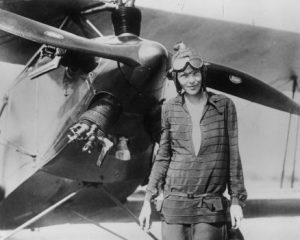ARCHIVAL MOMENT
June 17, 1928
As a passenger on the Friendship, (Fokker F7 airplane) Amelia Earhart, the first woman to hop the Atlantic, flew from Trepassey, Newfoundland, to Burry Port, Wales, on June 17, 1928.
The Friendship and crew successfully landed in Newfoundland on June 5 only to encounter gales or fog for days that prohibited their takeoff for Europe.
Earhart Arrives in Trepassey, June 5, 1928
···· The Friendship circled Trepassey twice before putting down in the choppy water of the harbor after a flight of 4 hours, 24 minutes. As the big monoplane taxied slowly toward the small cluster of houses on the eastern shore that was the town of Trepassey, dories full of men whirling ropes (Amelia called them maritime cowboys), each evidently hoping to guide them in, surrounded the Friendship, …
The town magistrate, Fred Gill, and his two sons, Burnham and Hubert, waiting near the monoplane in a dory, secured the honor of giving Amelia and Bill Stultz (pilot) a ride to the dock. Slim Gordon (mechanic) came later, after tending to the plane.
The children of Trepassey, who had been watching and waiting at the windows of the convent school facing the harbour, ran down to the shore en masse. Amelia “had a vision of many white pinafores and aprons on the dock,” and was under the impression that school had let out early so that the children could greet them. In fact the children had simply fled without permission for which they were made to stay late. She went up and visited with the children later at the convent school; the nuns were scandalized by the sight of a woman in pants.
One of the Telegrams that was sent to Amelia Earhart in Trepassey from a friend George, (Putnam) knowing that Amelia had not packed a change of clothing wired:
“SUGGEST YOU GO INTO RETIREMENT TEMPORARILY WITH NUNS AND HAVE THEM WASH SHIRT ETC –STOP”
It was arranged that the three fliers would spend the night at a small frame two story house with attached general Store belonging to Richard (Richie Dick) and Fanny Devereaux …. Mrs Devereaux too at first sight of Amelia in her “breeks” and boots was “quite overcome, and felt her to be sure I was present in the flesh.”
The Deveraux children, among them, a young girl who was to grow up to be Sister Theophane Curtis of the Presentation Congregation, the daughter of Fanny Deveraux from a previous marriage moved from their family home to live with relatives.
DEPARTURE FROM TREPASSEY – June 17, 1928
The team left Trepassey Harbor, Newfoundland, in a Fokker F7 on June 17, 1928, and arrived at Burry Port,Wales approximately 21 hours later, a distance of more than 2,010 miles (3,235 kilometers), in 20 hours 49 minutes.
When the crew returned to the States, they were greeted with a ticker-tape parade in New York and a reception held by President Calvin Coolidge at the White House. From then on, flying was the fixture of Earhart’s life.
On June 21, 1928 the prestigious New York Times newspaper following an interview with Amelia Earhart declared that Trepassey would be the site of a great international airport. The newspaper headline declared:
“Miss Earhart Predicts Great Airport at Trepassey for Transocean Flights.”
Earhart told the New York Times reporter:
“Trepassey ought to be someday, a great airport for transoceanic travel. It processes the finest harbor, perhaps the only harbor, adapted naturally for seaplane takeoffs in its part of the world.”
The experience in Trepassey might have been the inspiration for Earhart in the 1930’s to design a line of “functional” women’s clothing, including dresses, blouses, pants, suits, and hats, initially using her own sewing machine, dress form, and seamstress. She photographed well and modeled her own designs for promotional spreads.
Recommended Archival Collection: What do we have in the ‘Rooms Archives’ on this subject? Type Aeroplane or Flight in the search bar here: http://gencat1.eloquent-systems.com/webcat/request/DoMenuRequest?SystemName=The+Rooms+Public&UserName=wa+public&Password=&TemplateProcessID=6000_3355&bCachable=1&MenuName=The+Rooms+Archives
Recommended Archival Collection: The Rooms Provincial Archives holds a series of photographs (H5 – 32-35) taken of Amelia Earhart prior to commencing the world’s “first transatlantic solo flight by a woman”. Earhart took off from Harbour Grace, Newfoundland on 20 May 1932 and landed in Northern Ireland about 13 hours and 30 minutes later.
Recommended Reading: Earhart, Amelia. 1928. 20 Hrs., 40 min.: Our Flight in the Friendship. G.P. Putnam’s Sons:New York. (Reprinted in 2003 by National Geographic Adventure Classics:Washington.)
Recommended Website: The official Website of Amelia Earhart: http://www.ameliaearhart.com/




